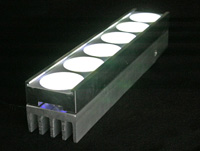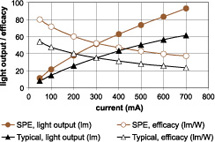
Improving White LED Efficiency Through Scattered Photon Extraction (SPETM)

LED fixture incorporating SPE technology.

Light output and efficacy of an SPE LED and a typical LED as a function of current. At low currents, the SPE LED produces 80 lm/W. |
Commercial white LEDs combine a light-emitting semiconductor with a phosphor to produce visible white light. The nature of most phosphors, however, causes more than half of the light, or photons, generated by the phosphor to divert back toward the semiconductor die, where much of it is absorbed and lost. This scattering reduces the LED’s overall light output.
LRC researchers have developed a Scattered Photon Extraction (SPETM) method to improve the light output and efficacy of white LEDs. The SPE method combines optimally shaped optics and placement of the phosphor away from the die. This configuration allows light traveling back toward the die to escape through the sides of the optics, generating 30 to 60 percent more light output (lumens) and luminous efficacy (lumens per watt of electricity) than typical white LEDs. At low operating currents, the new SPE LEDs are able to achieve an efficacy of more than 80 lumens per watt (lm/W). The industry’s goal is to achieve 150 lm/W by 2012. Moreover, moving the phosphor layer improves LED life.
TECHNICAL PAPERS
Narendran, N., Y. Gu, J.P. Freyssinier-Nova, and Y. Zhu. 2005. Extracting phosphor-scattered photons to improve white LED efficiency. phys. stat. sol. (a) 202 (6): R60-R62.
Journal Abstract
Narendran, N. 2005. Improved performance white LED. Fifth International Conference on Solid State Lighting, Proceedings of SPIE 5941: 45-50.
Full-text PDF
PROJECT-RELATED NEWS
PROJECT LINK
For more about SPE, see Improving LED Light Output and Efficacy Through SPE™
This study was part of a larger project funded by the U.S. Department of Energy: High-Efficiency, Nitride-Based Solid-State Lighting
SPONSORS
United States Department of Energy
Cooperative Agreement No. DE-FC26-01NT41203
University of California at Santa Barbara
|


